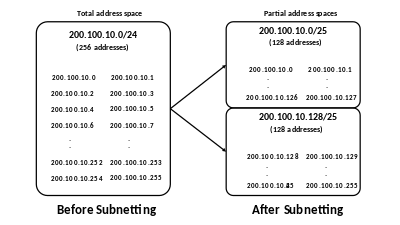Unlocking the secrets behind network addressing: Dive into the world of computational wizardry to unravel the art of calculating network addresses.
Calculating Network and Broadcast Addresses
Calculating the network and broadcast addresses is a crucial skill when working with computer networks. In Linux, this can be done using a simple formula.
To calculate the network address, you need to know the IP address and the subnet mask. The subnet mask is represented in the form of a slash followed by a number, such as /24. The number after the slash represents the number of bits in the subnet mask.
First, convert the IP address and the subnet mask to binary using positional notation. Each digit in a binary number represents a power of 2, with the rightmost digit representing 2^0, the next digit representing 2^1, and so on.
Next, perform a bitwise AND operation between the IP address and the subnet mask. This means comparing each bit of the IP address with the corresponding bit of the subnet mask. If both bits are 1, the result is 1. Otherwise, the result is 0.
The result of this bitwise AND operation will give you the network address. Convert this binary result back to decimal to obtain the network address in standard notation.
For example, let’s say you have an IP address of 192.168.1.100 and a subnet mask of /24. Convert the IP address and the subnet mask to binary:
IP address: 11000000.10101000.00000001.01100100
Subnet mask: 11111111.11111111.11111111.00000000
Perform the bitwise AND operation:
11000000.10101000.00000001.01100100
11111111.11111111.11111111.00000000
—————————————
11000000.10101000.00000001.00000000
Convert the result back to decimal:
192.168.1.0 is the network address.
Calculating the broadcast address is similar. Instead of performing a bitwise AND operation, you perform a bitwise OR operation between the IP address and the bitwise complement of the subnet mask.
The bitwise complement is obtained by flipping all the bits in the subnet mask. For example, if the subnet mask is /24, the bitwise complement would be 0.0.0.255.
Perform the bitwise OR operation between the IP address and the bitwise complement of the subnet mask. Convert the result back to decimal to obtain the broadcast address.
For example, using the same IP address and subnet mask as before:
IP address: 11000000.10101000.00000001.01100100
Bitwise complement of subnet mask: 00000000.00000000.00000000.11111111
Perform the bitwise OR operation:
11000000.10101000.00000001.01100100
00000000.00000000.00000000.11111111
—————————————
11000000.10101000.00000001.11111111
Convert the result back to decimal:
192.168.1.255 is the broadcast address.
By understanding and being able to calculate the network and broadcast addresses, you can effectively manage and troubleshoot computer networks. Linux training can provide you with the skills and knowledge necessary to excel in this field. So, if you’re interested in pursuing a career in networking, consider taking Linux training courses to enhance your skills and increase your job prospects.
Understanding IPv4 and IPv6 Subnet Calculations

In the world of networking, the Internet Protocol version 4 (IPv4) and Internet Protocol version 6 (IPv6) are the two main protocols used to route data packets across computer networks. Both protocols use positional notation, which is a system of representing numbers using digits in different positions.
When it comes to subnet calculations, the most important concept to understand is binary numbers. In binary, there are only two digits: 0 and 1. These digits can be used to represent any numerical digit, just like in decimal notation. However, in binary, each digit has a different value based on its position. For example, the rightmost digit represents 2^0 (which is 1), the next digit to the left represents 2^1 (which is 2), the next digit represents 2^2 (which is 4), and so on.
To calculate a network address, you need to use a subnet mask. A subnet mask is a binary number that is used to divide an IP address into network and host portions. It is represented using the slash notation (e.g., /24 for IPv4), which indicates the number of bits set to 1 in the subnet mask.
To calculate the network address, you perform a bitwise AND operation between the IP address and the subnet mask. This operation compares each bit in the IP address and subnet mask and returns a new binary number where the corresponding bits are set to 1 if both bits are 1, and 0 otherwise.
For example, let’s say you have an IPv4 address of 192.168.1.100 and a subnet mask of 255.255.255.0 (/24). To calculate the network address, you convert both the IP address and subnet mask to binary and perform the bitwise AND operation. The result is 192.168.1.0, which is the network address.
Understanding subnet calculations is essential for routing in computer networks. Routers use subnet calculations to determine the network address of a destination IP address so they can correctly forward network packets.
While subnet calculations may seem complex at first, with practice and the right tools, such as a subnet calculator or an online subnet calculator, you can quickly and accurately calculate network addresses. These tools provide a user-friendly interface where you can input the IP address and subnet mask and get the network address as the output. Some tools even provide additional information, such as the range of valid IP addresses within the subnet.
Step-by-Step Guide to Calculating Network and Broadcast Addresses
Calculating the network and broadcast addresses is an essential skill for anyone working with computer networks. Whether you’re a network administrator or just someone interested in learning more about networking, understanding how to calculate these addresses is crucial.
To calculate the network address, you’ll need to know the IP address and the subnet mask. The IP address is a numerical digit that identifies a specific device on a network, while the subnet mask determines the size of the network. The subnet mask is usually represented in a format called CIDR notation, which is a combination of an IP address and a slash (/) followed by a number.
The first step is to convert the IP address and the subnet mask into binary form. This can be done by converting each octet (a group of 8 bits) of the IP address and subnet mask into binary. For example, if the IP address is 192.168.0.1 and the subnet mask is /24, you would convert each octet into binary.
Once you have the IP address and subnet mask in binary form, you can determine the network address. To do this, you perform a bitwise AND operation on each bit of the IP address and the corresponding bit of the subnet mask. The result of this operation will give you the network address.
For example, if the IP address is 11000000.10101000.00000000.00000001 and the subnet mask is 11111111.11111111.11111111.00000000, performing a bitwise AND operation on each bit will give you the network address of 11000000.10101000.00000000.00000000.
Calculating the broadcast address is similar to calculating the network address. The only difference is that instead of performing a bitwise AND operation, you perform a bitwise OR operation on each bit of the IP address and the inverted subnet mask. The inverted subnet mask is obtained by flipping all the bits of the subnet mask.
For example, if the subnet mask is 11111111.11111111.11111111.00000000, the inverted subnet mask would be 00000000.00000000.00000000.11111111. Performing a bitwise OR operation on each bit of the IP address and the inverted subnet mask will give you the broadcast address.
Calculating the network and broadcast addresses is a fundamental skill in networking. It allows you to determine the range of IP addresses that are available for use on a particular network. This information is crucial for setting up routing and ensuring that network packets are delivered to the correct destination.
So, whether you’re a network administrator or just someone interested in learning more about networking, mastering the art of calculating network and broadcast addresses is essential. With a solid understanding of binary operations and a little bit of practice, you’ll be able to calculate these addresses with ease. So don’t let the thought of calculations and binary scare you away – with a little bit of practice, you’ll be a master in no time.



